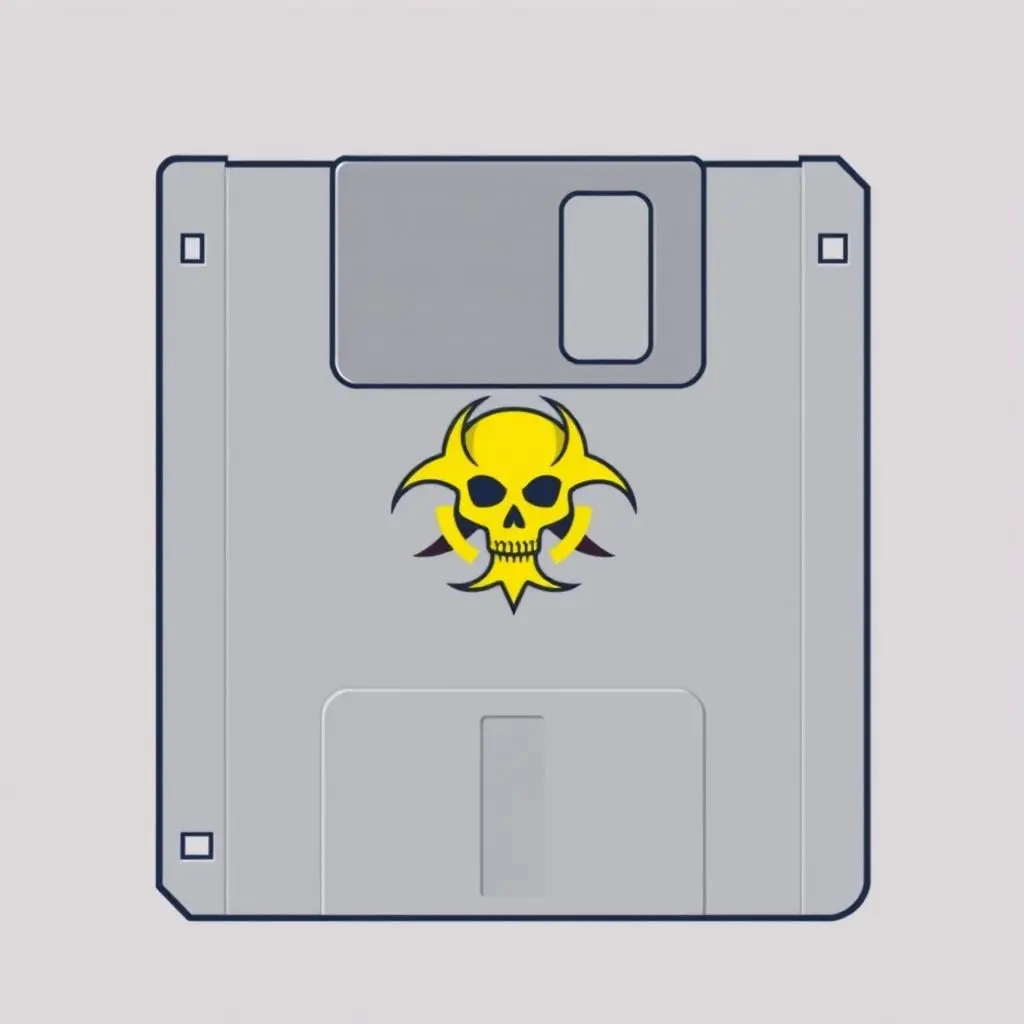Imagine checking your mail, not for bills or junk flyers, but for a floppy disk containing a digital menace. Sounds like something out of a retro sci-fi movie, right? Yet, bizarrely, this was the reality for thousands in 1989, marking the birth of a threat we now know all too well: ransomware.
Way back before email was ubiquitous and broadband was even a concept for most, the world met its very first documented ransomware threat. It wasn’t delivered through a phishing link or a malicious attachment in your inbox. Nope, it arrived via good ol’ fashioned postal service, tucked inside a seemingly innocent envelope.
Table of Contents
The Mail-Order Malware: Floppy Disks and the AIDS Trojan
In a move that seems almost unbelievable today, thousands of 5.25-inch floppy disks were mailed out globally. These disks, labelled ‘AIDS Information Introductory Diskette,’ were purportedly distributed to attendees of a World Health Organization (WHO) AIDS conference in Stockholm and mailed to addresses scraped from subscriber lists of AIDS-related publications.
The recipient demographic wasn’t accidental. The perpetrator targeted individuals and institutions involved in AIDS research, treatment, and education – people likely to be using computers extensively for data management and analysis, and perhaps, tragically, less focused on nascent computer security concerns.
Unbeknownst to them, inserting this disk into their IBM-compatible PC and running the program wasn’t going to deliver helpful information. Instead, it installed a program that lay dormant, waiting for a specific trigger.

Inside the PC Cyborg: What the AIDS Trojan Did
This pioneering piece of malware, later dubbed the AIDS Trojan or PC Cyborg, wasn’t immediately disruptive. It was designed to count how many times the computer booted up. Once that count reached 90, the Trojan sprang into action.
Instead of destroying data outright, it encrypted the filenames on the user’s hard drive, specifically in the root directory and potentially others. This rendered the files inaccessible and the system difficult to navigate, effectively holding the user’s data hostage. A message then appeared on the screen, informing the user that their software license had expired due to violation of the lease agreement.
To regain access to their files, the victim was instructed to send a payment of $189 (or $378 for a ‘lifetime lease’) to a Post Office Box in Panama. The payment was to be sent to ‘PC Cyborg Corporation’. This demand for payment to unlock access to data is the defining characteristic of ransomware, making the AIDS Trojan the undeniable ancestor of today’s sophisticated attacks.
Imagine explaining this to your IT department (if you even had one back then) or, worse, your boss! ‘So, I put this disk in, and now my files are gone unless I mail $189 to Panama…’ It was a bizarre, unprecedented situation.
The Man Behind the Scheme? Dr. Joseph Popp
Suspicion for the creation and distribution of the AIDS Trojan quickly fell upon Dr. Joseph Popp, an evolutionary biologist with a somewhat erratic background. Popp was apprehended in Amsterdam shortly after the attacks surfaced.
His motives remain somewhat murky and debated. While some reports suggest he claimed the profits were intended for AIDS research, his methods and subsequent behaviour were highly unusual. During his trial in the UK, Popp was declared mentally unfit to stand trial, and the case against him was eventually dropped. To this day, the full story of his involvement and motivations is subject to historical speculation and conflicting accounts.
A Not-So-Sophisticated Lock: Weaknesses and Swift Remedies
Thankfully for the victims, the AIDS Trojan was rudimentary by modern standards. Its encryption method was incredibly weak – it used a simple symmetric cipher and reportedly stored the key *within the code of the Trojan itself*, albeit in a modified form.
Computer security experts at the time quickly analyzed the malware. Because the encryption wasn’t strong and the method was discoverable, utilities were rapidly developed and distributed to decrypt the filenames and restore access without paying the ransom. Programs like ‘AIDSOUT’ and ‘CLEANUP’ became lifesavers for infected users, appearing relatively soon after the threat emerged.
The ease with which it was defeated prevented it from becoming a widespread catastrophe, but its impact on the concept of digital extortion was profound.

A Chilling Precedent for Digital Extortion
While the AIDS Trojan might seem like a quirky footnote in history compared to today’s massive ransomware operations, its significance cannot be overstated. It was the proof-of-concept for data hostage-taking for financial gain. It established the extortion model that cybercriminals still use, albeit with vastly more sophisticated tools and delivery mechanisms.
It showed that infecting a user’s computer could be directly monetized, bypassing traditional routes of theft or fraud. From a floppy disk mailed across borders to complex phishing campaigns, drive-by downloads, and weaponized software vulnerabilities, the threat landscape has undeniably evolved. But the core principle – lock data, demand money – was born with the PC Cyborg.
If you think sending malware by post is wild, check out our YouTube Short diving into this strange piece of tech history!
Watch our quick take on the AIDS Trojan! (Note: YouTube Video ID missing, placeholder used)
Frequently Asked Questions (FAQs)
Q: Was the AIDS Trojan the first computer virus?
A: No, the AIDS Trojan was not the first computer virus. Viruses like the Elk Cloner (1982) and Brain (1986) predate it. However, it is widely considered the first *ransomware* – malware specifically designed to extort money by restricting access to data.
Q: How many people were affected?
A: Estimates vary, but thousands of disks were mailed out globally. While not every recipient ran the program or triggered the payload, a significant number of users were likely affected before fixes became available.
Q: Did anyone pay the ransom?
A: It’s difficult to say definitively how many people, if any, paid the ransom before decryption tools were released. Given the relatively quick availability of fixes and the strange nature of the demand, it’s possible the number was low.
Q: Why did it target AIDS researchers?
A: The exact motivation for targeting this specific group is debated, particularly given the alleged creator’s background. Some theories suggest it was an attempt to exploit a group perceived as having valuable data and potentially less focus on computer security at the time. Popp himself reportedly made claims related to funding AIDS research, but these claims are questionable.
Q: How did they distribute the decryption tools?
A: In the era before widespread internet access, decryption tools were distributed through bulletin board systems (BBS), floppy disks shared among users, and potentially via traditional mail or phone calls for instructions, relying on the emerging network of computer enthusiasts and early security experts.
The Long Shadow of a Floppy Disk
The story of the AIDS Trojan is a fascinating, slightly bizarre, and cautionary tale from the early days of personal computing. It highlights that the fundamental concepts of cybercrime – exploiting vulnerabilities, targeting specific groups, and monetizing access – have been present for decades, even evolving from physical mail to complex digital attacks.
It serves as a potent reminder that while technology races forward, the ingenuity of those seeking to misuse it evolves right alongside. The mail-order floppy disk attack of 1989 may seem archaic, but its legacy lives on in every ransomware headline we see today.




